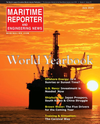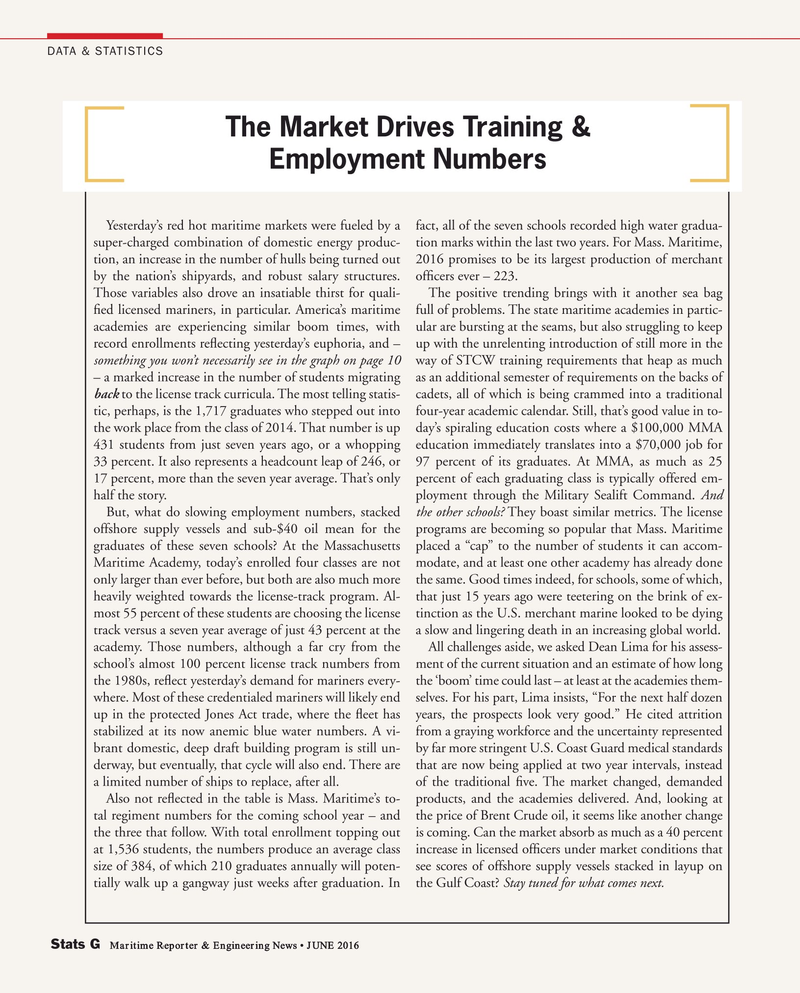
Page 73: of Maritime Reporter Magazine (June 2016)
Annual World Yearbook
Read this page in Pdf, Flash or Html5 edition of June 2016 Maritime Reporter Magazine
DATA & STATISTICS
The Market Drives Training &
Employment Numbers
Yesterday’s red hot maritime markets were fueled by a fact, all of the seven schools recorded high water gradua- super-charged combination of domestic energy produc- tion marks within the last two years. For Mass. Maritime, tion, an increase in the number of hulls being turned out 2016 promises to be its largest production of merchant by the nation’s shipyards, and robust salary structures. of? cers ever – 223.
Those variables also drove an insatiable thirst for quali- The positive trending brings with it another sea bag ? ed licensed mariners, in particular. America’s maritime full of problems. The state maritime academies in partic- academies are experiencing similar boom times, with ular are bursting at the seams, but also struggling to keep record enrollments re? ecting yesterday’s euphoria, and – up with the unrelenting introduction of still more in the something you won’t necessarily see in the graph on page 10 way of STCW training requirements that heap as much – a marked increase in the number of students migrating as an additional semester of requirements on the backs of back to the license track curricula. The most telling statis- cadets, all of which is being crammed into a traditional tic, perhaps, is the 1,717 graduates who stepped out into four-year academic calendar. Still, that’s good value in to- the work place from the class of 2014. That number is up day’s spiraling education costs where a $100,000 MMA 431 students from just seven years ago, or a whopping education immediately translates into a $70,000 job for 33 percent. It also represents a headcount leap of 246, or 97 percent of its graduates. At MMA, as much as 25 17 percent, more than the seven year average. That’s only percent of each graduating class is typically offered em- half the story. ployment through the Military Sealift Command. And
But, what do slowing employment numbers, stacked the other schools? They boast similar metrics. The license offshore supply vessels and sub-$40 oil mean for the programs are becoming so popular that Mass. Maritime graduates of these seven schools? At the Massachusetts placed a “cap” to the number of students it can accom-
Maritime Academy, today’s enrolled four classes are not modate, and at least one other academy has already done only larger than ever before, but both are also much more the same. Good times indeed, for schools, some of which, heavily weighted towards the license-track program. Al- that just 15 years ago were teetering on the brink of ex- most 55 percent of these students are choosing the license tinction as the U.S. merchant marine looked to be dying track versus a seven year average of just 43 percent at the a slow and lingering death in an increasing global world.
academy. Those numbers, although a far cry from the All challenges aside, we asked Dean Lima for his assess- school’s almost 100 percent license track numbers from ment of the current situation and an estimate of how long the 1980s, re? ect yesterday’s demand for mariners every- the ‘boom’ time could last – at least at the academies them- where. Most of these credentialed mariners will likely end selves. For his part, Lima insists, “For the next half dozen up in the protected Jones Act trade, where the ? eet has years, the prospects look very good.” He cited attrition stabilized at its now anemic blue water numbers. A vi- from a graying workforce and the uncertainty represented brant domestic, deep draft building program is still un- by far more stringent U.S. Coast Guard medical standards derway, but eventually, that cycle will also end. There are that are now being applied at two year intervals, instead a limited number of ships to replace, after all. of the traditional ? ve. The market changed, demanded
Also not re? ected in the table is Mass. Maritime’s to- products, and the academies delivered. And, looking at tal regiment numbers for the coming school year – and the price of Brent Crude oil, it seems like another change the three that follow. With total enrollment topping out is coming. Can the market absorb as much as a 40 percent at 1,536 students, the numbers produce an average class increase in licensed of? cers under market conditions that size of 384, of which 210 graduates annually will poten- see scores of offshore supply vessels stacked in layup on tially walk up a gangway just weeks after graduation. In the Gulf Coast? Stay tuned for what comes next.
Stats G Maritime Reporter & Engineering News • JUNE 2016
STATS.indd 40 STATS.indd 40 6/20/2016 5:00:10 PM6/20/2016 5:00:10 PM
MN Jan16 Layout 1-17.indd 8 1/6/2016 3:23:58 PM

 72
72

 74
74
